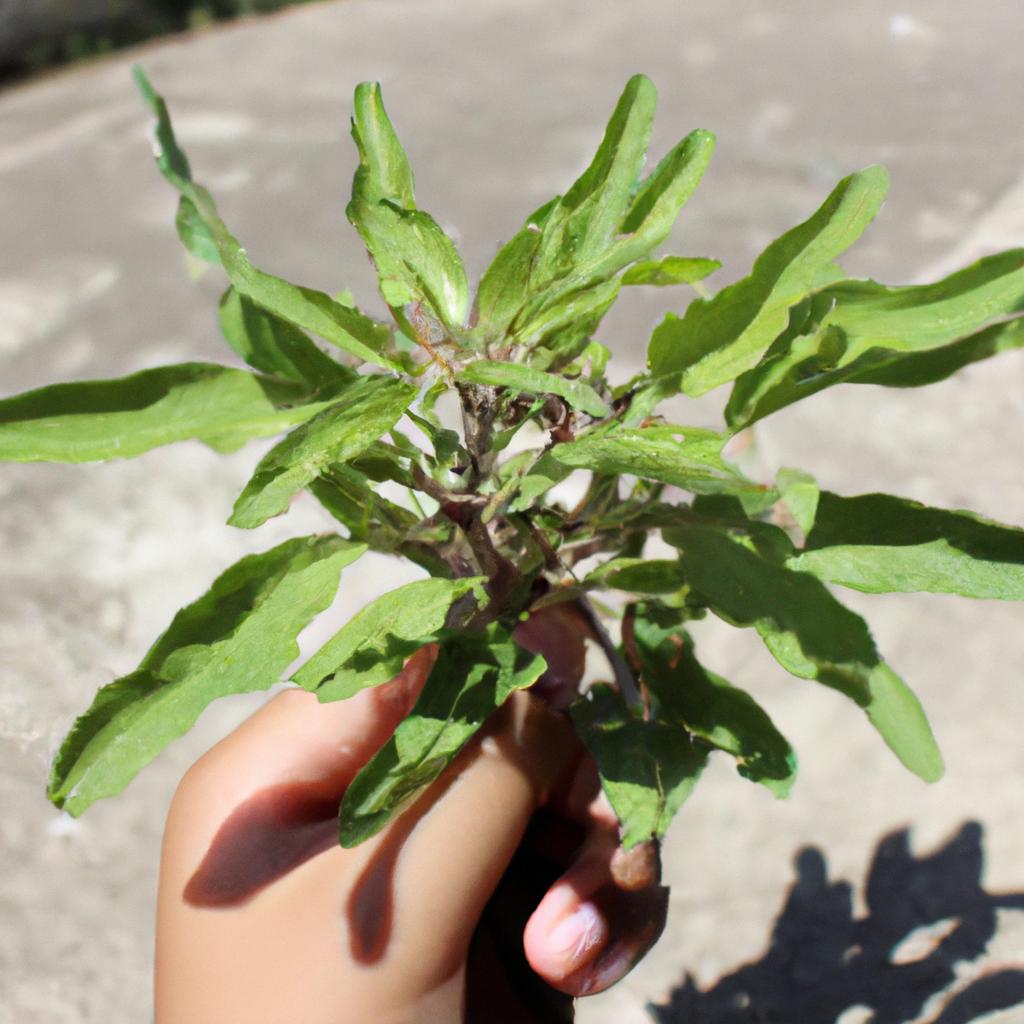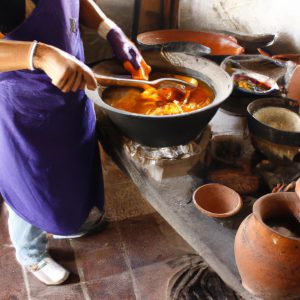Epazote, a lesser-known Mexican herb with a distinct flavor profile, has been gaining attention in culinary circles for its unique qualities and versatility. This article aims to shed light on the importance of epazote as an essential ingredient in Mexican cuisine by exploring its historical significance, cultural relevance, and various culinary uses. By delving into the multifaceted nature of this herb, readers will gain a deeper understanding of how epazote adds depth and complexity to traditional Mexican dishes.
To illustrate the impact of epazote on Mexican cuisine, let us consider the case study of a popular dish known as black bean soup. Traditionally prepared using dried beans simmered with aromatic vegetables and spices, this hearty soup serves as a staple meal in many households across Mexico. However, it is the addition of epazote that elevates this humble dish to new heights. With its pungent aroma and earthy undertones, epazote not only enhances the overall taste but also aids digestion due to its carminative properties. The presence of epazote in black bean soup showcases how this unassuming herb can significantly contribute to both the taste and nutritional value of a beloved dish.
History of Epazote
Imagine you are exploring the vibrant streets of Mexico City, indulging in the diverse flavors and aromas of Mexican cuisine. As you pass by a bustling market, your senses are captivated by the distinct fragrance emanating from a small herb stand. Curiosity piqued, you approach to discover epazote, an essential ingredient deeply rooted in Mexican culinary traditions.
Epazote (Dysphania ambrosioides) has a rich history that dates back centuries. Its usage can be traced back to pre-Columbian times when indigenous peoples recognized its medicinal properties and incorporated it into their traditional remedies. This ancient herb gained prominence as a culinary staple during the Aztec civilization, where it was appreciated for its unique flavor profile and digestive benefits.
To fully appreciate the significance of epazote, let us consider four key aspects that highlight its historical importance:
- Indigenous Heritage: The use of epazote transcends generations, serving as a link between past and present culinary practices within indigenous communities across Mexico.
- Medicinal Properties: Epazote possesses various health benefits such as aiding digestion and relieving intestinal discomfort, making it not only flavorful but also functional.
- Cultural Significance: Embedded in Mexican culture, epazote is seen as a symbol of tradition and heritage, connecting people through shared experiences and memories associated with its consumption.
- Culinary Diversity: From regional dishes like black bean soup to popular delicacies such as tamales or quesadillas, epazote adds depth and complexity to countless recipes throughout Mexico’s vast gastronomic landscape.
Now, armed with this understanding of epazote’s historical context and cultural relevance, we delve further into exploring its versatile role in Mexican cuisine. Join us on this gastronomic journey as we uncover the fascinating world of culinary uses for this remarkable herb.
Culinary Uses of Epazote
While the history of epazote provides us with valuable insights into its origins and cultural significance, it is equally important to explore the various culinary uses that this essential Mexican food ingredient offers. To illustrate its versatility, let’s consider a hypothetical scenario where a chef decides to incorporate epazote into their signature dish—a hearty black bean soup.
Epazote’s distinct flavor profile makes it an ideal addition to many traditional Mexican dishes. Its earthy and pungent taste adds depth and complexity to soups, stews, sauces, and even beverages. When added to our hypothetical black bean soup, epazote enhances the overall taste by imparting a unique herbal note that complements the richness of the beans.
To fully appreciate the culinary potential of epazote, let us delve into some key aspects of its usage:
-
Aromatic Enhancer:
- Releases an alluring aroma when heated.
- Infuses dishes with a pleasant fragrance reminiscent of citrus notes.
- Creates an inviting atmosphere in the kitchen while cooking.
-
Digestive Aid:
- Known for its carminative properties which help alleviate digestive discomfort.
- Traditionally used as a natural remedy for flatulence and other gastrointestinal issues.
- Adds a soothing element to meals, aiding digestion after indulging in flavorful Mexican cuisine.
-
Anti-parasitic Agent:
- Contains compounds believed to possess anti-parasitic properties.
- Used traditionally in Mexico to combat intestinal parasites such as worms.
- Offers a natural alternative for those seeking preventative measures or complementary treatments against parasitic infections.
-
Culinary Tradition:
| 🌱 | Deep-rooted connection between epazote and indigenous Mexican cuisines |
| 💚 | Symbolizes ancestral knowledge passed down through generations |
| 😋 | Represents the art of balancing flavors in traditional Mexican cooking |
| 🌍 | Embraces cultural diversity and highlights the importance of preserving culinary heritage |
Incorporating epazote into our culinary repertoire not only adds a unique twist to familiar recipes but also allows us to appreciate its rich cultural significance. The versatility, aromatic qualities, digestive benefits, and historical value make epazote an ingredient worth exploring further.
Transitioning seamlessly towards understanding the health benefits associated with this remarkable herb, let’s delve into how epazote contributes positively to our well-being.
Health Benefits of Epazote
As we delve deeper into the world of epazote, it is essential to explore its numerous health benefits. One fascinating example that highlights the potential of this Mexican herb involves a young woman named Maria, who struggled with chronic digestive issues for years. After incorporating epazote into her diet, Maria noticed a significant improvement in her symptoms, experiencing reduced bloating and improved digestion. This anecdotal evidence showcases just one of the many ways in which epazote can positively impact our well-being.
The health benefits of epazote are wide-ranging and have been recognized by traditional medicine systems for centuries. Here are some key reasons why including epazote in your diet may be beneficial:
- Digestive Aid: Epazote has traditionally been used as an herbal remedy for various digestive ailments such as indigestion, gas, and stomach cramps. Its carminative properties help ease discomfort and promote healthy digestion.
- Anti-parasitic Properties: Studies suggest that epazote possesses anti-parasitic activity, making it effective against intestinal worms and other parasites that can cause gastrointestinal distress.
- Anti-inflammatory Effects: The presence of certain compounds in epazote gives it anti-inflammatory properties. Regular consumption may help reduce inflammation within the body and alleviate associated symptoms.
- Antioxidant Richness: Epazote is packed with antioxidants like flavonoids and phenolic compounds, which protect against cellular damage caused by harmful free radicals.
To further illustrate the potential health benefits of incorporating epazote into your routine, consider the following table:
| Health Benefit | Potential Effect |
|---|---|
| Improved Digestion | Reduced bloating and enhanced nutrient absorption |
| Enhanced Detoxification | Increased elimination of toxins from the body |
| Strengthened Immunity | Boosted immune system function |
| Decreased Inflammation | Alleviation of symptoms associated with inflammatory conditions |
In summary, epazote holds great potential as a natural remedy for various health concerns. From its ability to aid digestion and combat parasites to its anti-inflammatory properties and antioxidant richness, this Mexican herb offers an array of benefits worth exploring.
Transitioning into the subsequent section about “How to Grow Epazote,” we will now delve into the practical aspects of cultivating this fascinating plant.
How to Grow Epazote
Epazote: Discovering the Essential Mexican Food Ingredient
Health Benefits of Epazote:
As we have explored in the previous section, epazote is a versatile herb that not only adds flavor to traditional Mexican dishes but also offers numerous health benefits. To further appreciate its significance, let’s consider a hypothetical scenario where Maria, a nutrition-conscious individual, incorporates epazote into her daily meals.
Maria suffers from occasional digestive discomfort and seeks natural remedies to alleviate her symptoms. She discovers that epazote possesses carminative properties known for their ability to relieve gas and bloating. Intrigued by this potential solution, she starts using fresh epazote leaves as an herbal infusion after meals. Over time, Maria notices a significant reduction in her digestive issues, leading her to embrace the herb as part of her wellness routine.
In addition to aiding digestion, there are several other notable health benefits associated with epazote consumption:
- Rich source of vitamins A and C
- Contains essential minerals such as iron and calcium
- Exhibits antimicrobial properties
- May contribute to weight management through its fiber content
To better understand these advantages at a glance, refer to the following table:
| Health Benefit | Description |
|---|---|
| Vitamins A and C | Supports immune system function |
| Iron and Calcium | Promotes healthy bones and red blood cell production |
| Antimicrobial | Helps combat harmful bacteria |
| Fiber | Contributes to feelings of fullness and aids in digestion |
Considering these remarkable qualities, it becomes evident why incorporating epazote into one’s diet can be beneficial beyond culinary purposes. In the subsequent section about “Epazote in Traditional Mexican Dishes,” we will explore how this herb enhances the flavors of various iconic recipes while offering its unique health-promoting properties. So let us continue our journey into the world of epazote, where its cultural significance and culinary applications await.
Epazote in Traditional Mexican Dishes
Imagine walking into a bustling Mexican restaurant, enveloped by the aroma of rich spices and vibrant flavors. As you peruse the menu, your eyes are drawn to dishes that boast the unmistakable taste of epazote. This ancient herb has long been an essential ingredient in traditional Mexican cuisine, adding a unique depth and character to various culinary creations.
From savory stews to zesty salsas, epazote finds its way into an array of beloved Mexican dishes. One shining example is the classic dish called “huitlacoche quesadillas.” These delectable treats feature corn truffles cooked with onions, garlic, and epazote leaves, all nestled between two warm tortillas. The earthy flavor of huitlacoche harmonizes beautifully with the boldness of epazote, creating a truly unforgettable gastronomic experience.
To fully appreciate the versatility and impact of this remarkable herb, let us delve into some key ways in which it is used in traditional Mexican cooking:
- Enhancing bean dishes: Epazote’s distinct taste pairs perfectly with beans, infusing them with a pungent yet enticing herbal note.
- Taming the heat: When added to spicy foods like chili peppers or salsas, epazote provides a subtle cooling effect while enhancing other flavors.
- Balancing richness: In hearty meat-based recipes such as mole sauce or slow-cooked barbacoa, epazote acts as a natural palate cleanser by cutting through fatty elements.
- Highlighting regional specialties: Different regions within Mexico have their own signature dishes where epazote takes center stage – from Oaxacan tamales wrapped in banana leaves to Veracruz-style fish stew known as “caldo de camarón.”
| Dish | Epazote Usage |
|---|---|
| Pozole | Added during simmering |
| Tacos al Pastor | Sprinkled on marinated pork |
| Enchiladas Verdes | Blended with tomatillo sauce |
| Chiles Rellenos | Mixed into cheese filling |
By exploring these traditional Mexican dishes and their ingenious use of epazote, you gain insight into the immense value this herb brings to the culinary world. In the forthcoming section about “Epazote Substitutes,” we will explore alternative options that can mimic its distinct flavor profile without compromising on authenticity or taste.
Epazote Substitutes
While epazote is a popular and essential ingredient in traditional Mexican dishes, there may be instances where it is not readily available or preferred. Luckily, there are several substitutes that can replicate the unique flavor profile of epazote. Let’s explore some viable alternatives to this cherished herb.
One example of an effective substitute for epazote is cilantro. Although distinct in taste, cilantro offers a similar earthy and citrusy flavor that complements many Mexican dishes. For instance, imagine preparing a delicious pot of black bean soup without access to fresh epazote leaves. By substituting it with chopped cilantro, you can still achieve a vibrant and aromatic dish that will satisfy your cravings for authentic Mexican flavors.
- Oregano: Known for its versatility, oregano can add depth and complexity to recipes calling for epazote.
- Culantro: Often referred to as “Mexican coriander,” culantro possesses a strong aroma reminiscent of both cilantro and parsley.
- Mexican tarragon: With its licorice-like flavor, Mexican tarragon serves as an excellent alternative when creating savory Mexican sauces or marinades.
| Substitute | Flavor Profile |
|---|---|
| Cilantro | Earthy and citrusy |
| Oregano | Aromatic and versatile |
| Culantro | Strong aroma |
| Mexican Tarragon | Licorice-like |
By incorporating any of these substitutes into your recipes, you can successfully recreate the essence of epazote even if it may not be easily accessible. Experimenting with different combinations will allow you to find the perfect substitute that suits your personal preferences while maintaining the authenticity of your Mexican dishes. So, next time epazote is not at hand, fear not! These alternatives will ensure that your culinary endeavors continue to be infused with the vibrant flavors of Mexico.











More Stories
Mexican Oregano: The Essential Ingredient in Mexican Food
Cilantro: The Essential Ingredient in Authentic Mexican Cuisine
Limes: A Vital Ingredient in Authentic Mexican Food